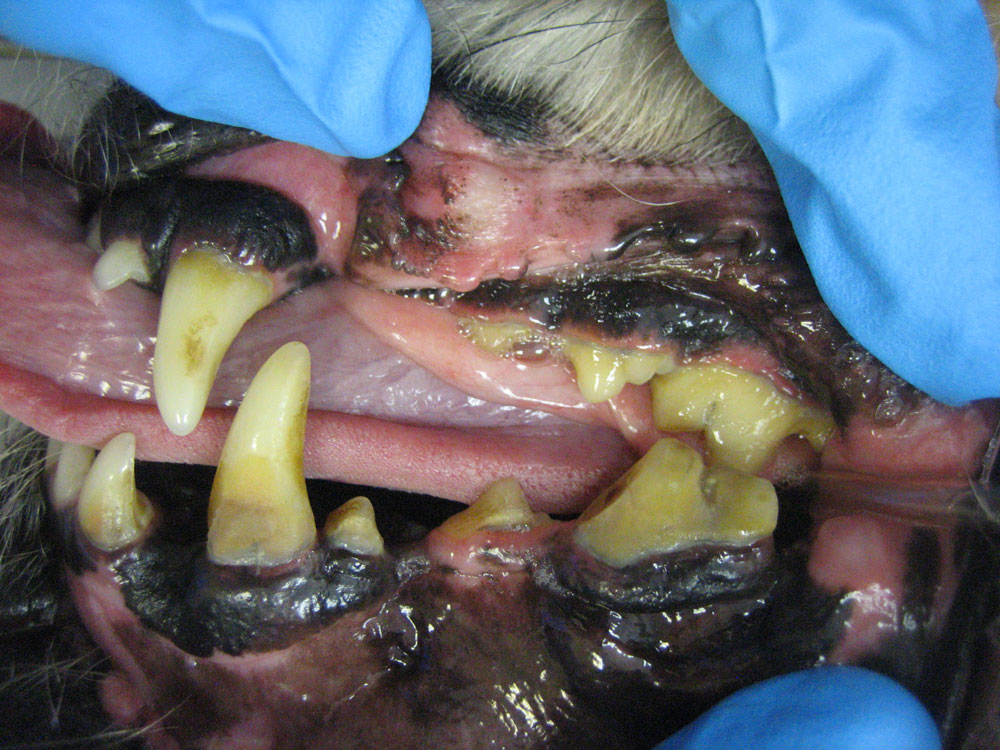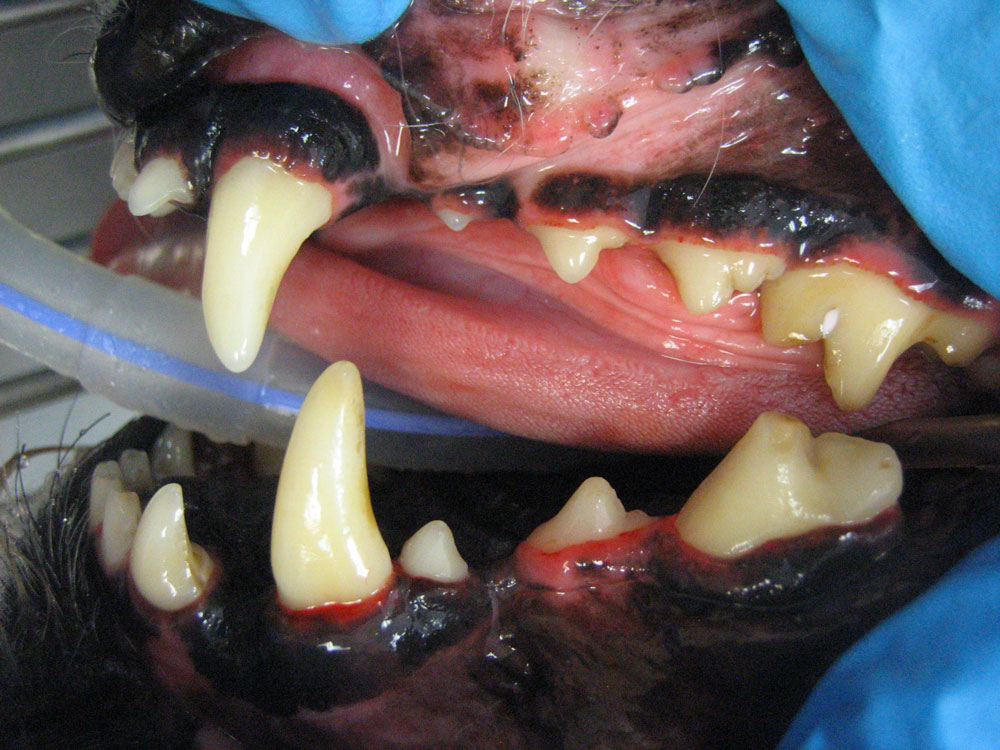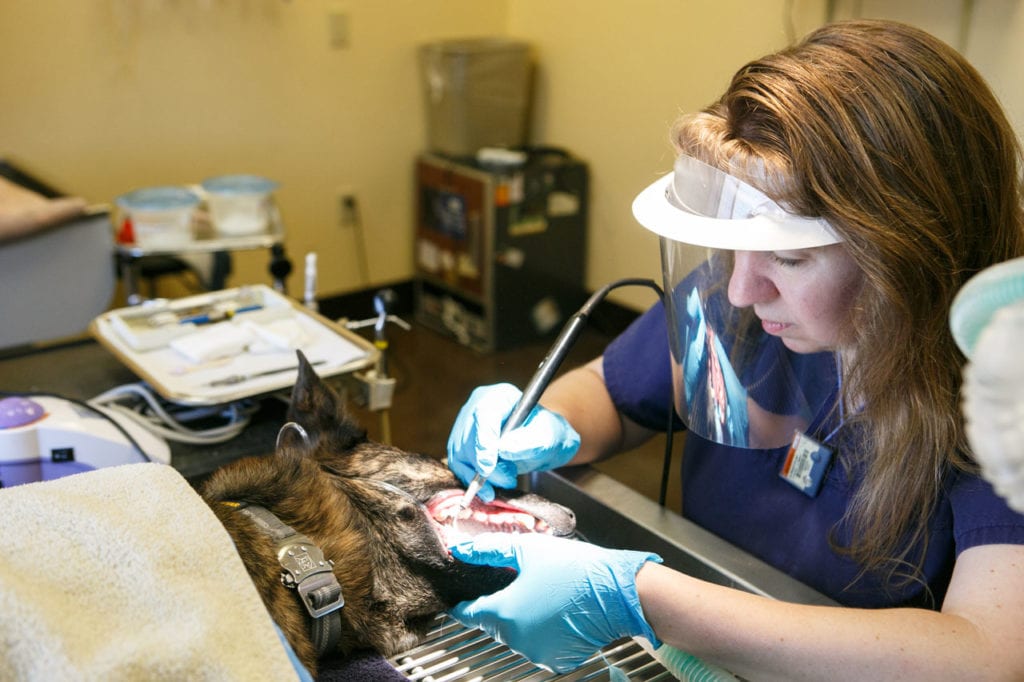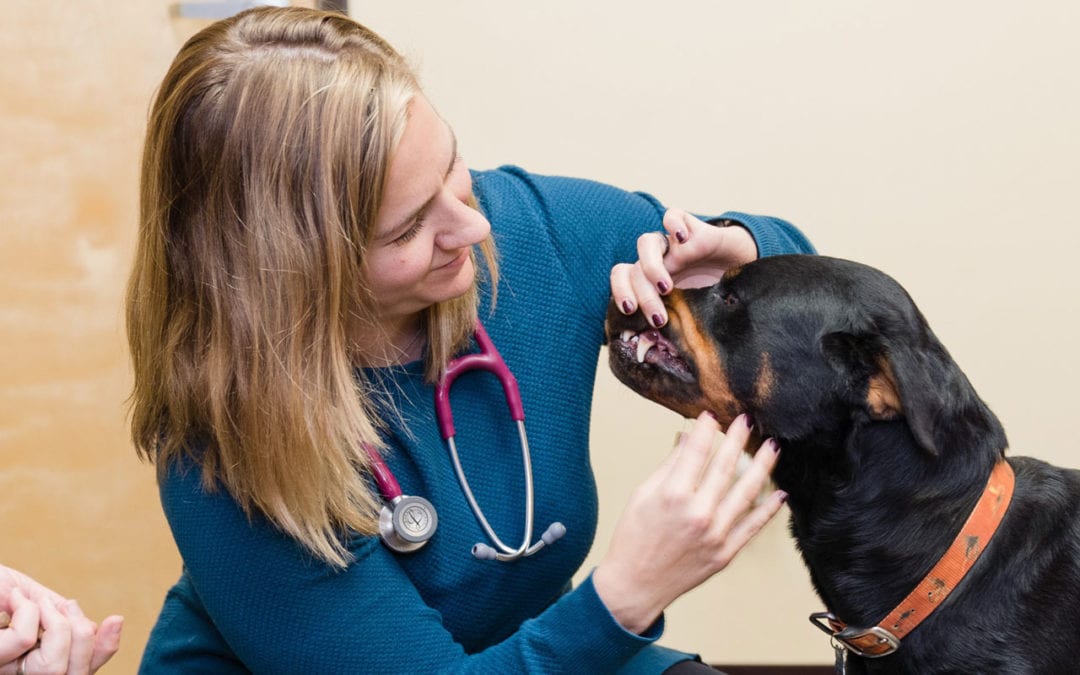Written by Dr Jennifer Kelley, DVM
February is National Dental Month! Did you know that periodontal disease is one of if not the most common diseases that occur in our pets? Periodontal disease ranges from inflammation of the gums (gingivitis), to severe infection and loss of the bone surrounding the teeth (periodontitis). In this article we will talk about periodontal disease and its signs in our pets, the connections between having a healthy mouth and a healthy pet overall, as well as options for preventing and treating periodontal disease in our furry family members!
So what is periodontal disease (PD) and how does it develop? PD occurs when bacteria accumulate and form plaque between the teeth and the gums. If the plaque is not physically removed populations of bacteria that can cause destruction of the healthy gums and bone surrounding the tooth increase and lead to inflammation, infection and bone loss. Reddening and swelling of the gums (gingivitis) is the first sign of periodontal disease. If the offending plaque and bacteria are removed at this stage bone loss and infection can often be prevented. If the plaque is not removed at least every 2-3 days, it can turn into hard dark brown calculus/tartar. Calculus provides a hard shield that protects destructive bacteria from being removed by brushing. Under their protective covering the bacterial populations become more strongly established and anaerobic bacteria, those that do not need oxygen, start to predominate and cause inflammation, infection and bone loss (periodontitis). So what can you do at home to stop the progression of periodontal disease?
Just like in people, plaque is best removed by brushing. We discussed that plaque turns into calculus in 2-3 days. Calculus is firmly anchored to the tooth and needs to be removed with a hand or ultrasonic scaler, which for our pets is best performed under general anesthesia, more on that later! To prevent plaque from turning into calculus it is best to brush every day to every other day. If you brush every 3 days or less frequently than the plaque will have a chance to turn into calculus. So when should you start brushing your dog’s teeth? If you start when your dog is a puppy you can get them used to the process and help prevent calculus accumulation. If your dog is older they likely already have some calculus and brushing will help prevent it from continuing to accumulate until it can be removed while your pet is anesthetized.
There are many other options for dental home care for the pet that just does not tolerate teeth brushing, and that will also benefit your pet even if you brush! Dental chews such as rawhides that contain enzymes designed to break down plaque can be given once daily. The chewing action helps mechanically brush the teeth while the enzymes also help break down the plaque. Hard chews such as bones and antlers are not recommended since dogs can fracture their teeth on them. Swallowing hard chunks of bone can also cause problems in their gastrointestinal tracts that can require surgery to correct. Other home care options include water additives and oral gels that help prevent plaque formation. Dental diets can also be fed which are made of larger than normal kibbles that are designed to provide some resistance and crunch when chewed to “brush” the dog or cat’s teeth as they eat. The take home message on home care is that mechanically removing plaque with brushing, dental chews and diets is the most effective way to remove plaque and help maintain oral health. Please visit the Veterinary Oral Health Council website www.vohc.org for a complete list of oral home care products approved for dogs and cats.

Before Cleaning

After Cleaning
So you brush your pet’s teeth and/or provide other forms of home oral care, why does your veterinarian still recommend a yearly anesthetized oral exam and cleaning? Well that pesky calculus likes to develop under the gums and brushing and anesthesia free cleanings cannot reach the majority of this well hidden calculus. It is best removed with an ultrasonic and/or hand scaler while your pet is being well monitored under anesthesia. The teeth then need to be polished with a low speed hand piece so that the tiny grooves created in the enamel by the scalers can be smoothed out. Those grooves can serve as channels for bacteria to stick more easily to the tooth so scaling the teeth without polishing can actually make plaque and calculus form faster. But cleaning the teeth during an anesthetized dental procedure is only one part of a thorough oral exam and treatment planning!
Not all teeth with gingivitis progress to the more aggressive periodontitis that causes bone loss, but all teeth with periodontitis have gingivitis. What does this mean? Your veterinarian gets a quick look at your pet’s teeth when they are awake in the exam room. We then grade their overall dental health on this quick visual assessment, but to really assess the health of each tooth and differentiate gingivitis from periodontitis we need to do two things. The patient needs to be completely still so we can probe around the tooth with a special instrument for any evidence of bone loss and compare those findings with x-rays of each tooth to assess the health of the bone and tooth roots. The only way to obtain this information is when our pets are completely still and relaxed under general anesthesia. When your pet is anesthetized we evaluate their entire oral cavity to look for any abnormalities. In addition to evidence of periodontal disease, we look for changes like cancerous masses, tooth fractures and cavities that can be very difficult if impossible to see on an awake patient. Most often any abnormalities found can be treated while your pet is already anesthetized.

So what signs observed at home can help indicate that your pet is due for an anesthetized oral examination and cleaning? Bad breath is one of the most common signs. It can come on gradually and be difficult to notice when you are around your pet all the time. Ask your friend or family member if they notice a change in their breath! Dogs and cats are usually extremely stoic when it comes to oral pain. They will even continue to eat when they have broken and severely diseased teeth! Clues that your pet may have oral pain include changes in chewing behavior. They may not want to chew on their favorite toys as much, chew more gingerly or develop a change in food preference. Meaning if they liked dry food best before they may start to prefer wet or vice versa. Cats may not groom as much as they used to or stop grooming all together. They may just not seem as bright and active as they used to. All of these changes can be subtle signs of oral pain.
Maintaining your pet’s oral health also helps keep them healthy overall. When periodontitis occurs, bacteria are able to transiently access your pet’s bloodstream due to breakdowns in the barriers that keep the normal oral bacteria in check. Bacteria in the bloodstream can then shower your pet’s organs such as the heart, liver and kidneys. For this reason dogs with severe periodontal disease are more likely to have kidney disease, heart and liver disease. By maintaining their oral health we can help protect their internal organs as well.
We hope this article has given you more information about your pet’s oral health. The inside of the mouth is often out of sight and out of mind, but in this case an ounce of prevention is truly worth a pound of cure. By preventing periodontal disease from progressing with brushing, oral home care and anesthetized oral exams and cleanings, we can help pets keep their teeth and have happy, healthy smiles for years to come.

